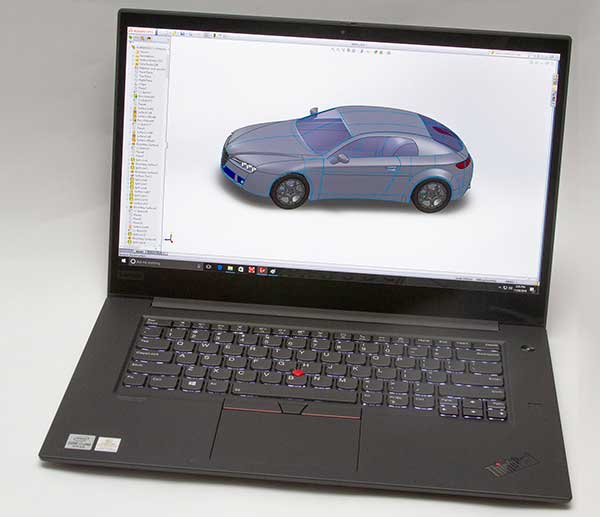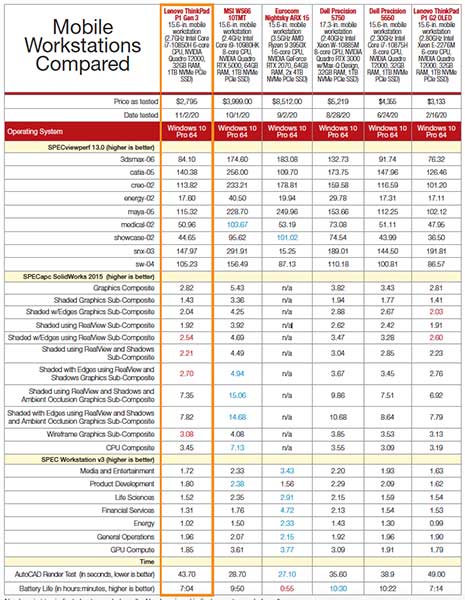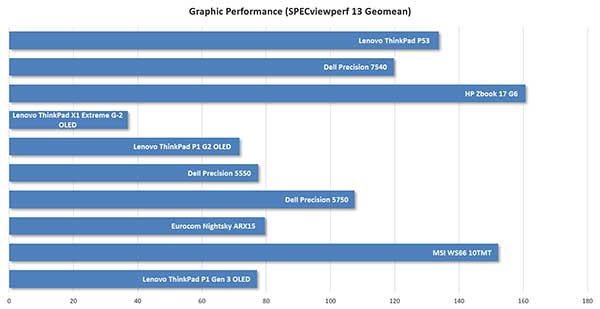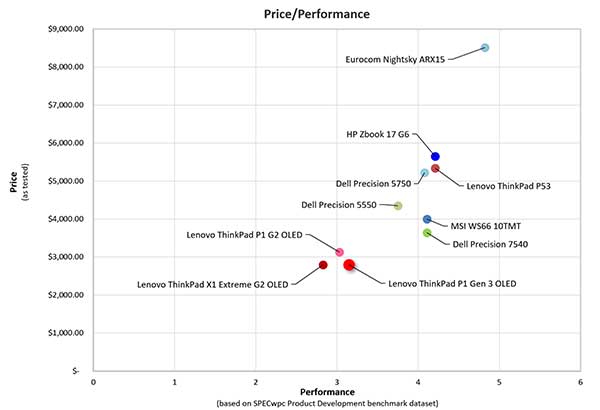Lenovo ThinkPad P1 G3 OLED: Still Nearly Perfect
The next step in the evolution of an excellent 15.6-in. mobile workstation does not disappoint.

The Lenovo ThinkPad P1 Gen 3 OLED. Image courtesy of David Cohn.
Latest News
February 26, 2021
Since our first glimpse in 2018, we have been extremely impressed with the ThinkPad P1, Lenovo’s lightweight 15.6-in. mobile workstation. When we reviewed that first iteration, we concluded that it was the perfect combination of performance, portability and price.
The second generation (DE, August 2020) reinforced that opinion, so we had high expectations when Lenovo sent us a third-generation system to review. Happily, the new ThinkPad P1 Gen 3 OLED exceeded those expectations.
From the outside, there is no discernible difference between the second and third generations. The Lenovo ThinkPad P1 Gen 3 is housed in a charcoal gray carbon fiber and magnesium alloy case with the same carbon fiber weave introduced in the previous release.
The system has the exact same dimensions as its predecessor—14.25x9.69x0.87 in.—and weighs 3.75 lbs., nearly identical to the Gen 2 release (which was already a few ounces lighter than the first-generation ThinkPad P1). It is powered by a 135-watt power supply, which measures 5.0x3.0x0.87-in. and weighs 1.03 lbs. The lid features the same ThinkPad logo with a glowing red dot over the “I.”
The ThinkPad P1 Gen 3 base configuration now has a starting price of $1,259, nearly $200 less than its predecessor. That base system comes with a 10th-generation Intel Core i7-10750H 6-core 2.6GHz processor, an NVIDIA Quadro T1000 discrete graphics processor, a 1920x1080 in-plane switching display with a rated brightness of 300 nits, 8GB of 2933MHz RAM, a 256GB M.2 PCIe non-volatile memory express (NVMe) solid-state drive (SSD), a 720p webcam, a fingerprint reader, Wi-Fi, Bluetooth and a copy of Windows 10 Pro 64, backed by a one-year warranty.
Superb Keyboard and Display Choices
Raising the lid reveals the same seamless spill-resistant keyboard with 84 mostly full-size keys as in previous generations. Two levels of backlighting can be toggled by pressing the Fn key and spacebar. Although the ThinkPad P1 lacks a separate numeric keyboard, the Lenovo keyboard offers perhaps the best typing experience available in any laptop.
A round power button is located to the upper-right of the keyboard and a 4x2.75-in. touchpad with three buttons is centered below the spacebar. There is also the familiar red Lenovo pointing stick nestled between the G, H and B keys. The caps lock key has its own LED, as do the keys dedicated to the speakers, microphone and function lock.
A narrow bezel surrounds the display panel, yet still provides space above the panel for the webcam, which includes a privacy shutter. Lenovo offers a choice of four display panels, including a brighter (500 nits) full high-definition (1920x1080) display and two different ultra high-definition (3840x2160) displays.
All three high-priced panels include Dolby Vision high dynamic range and infrared cameras. The top-of-the-line display, included in our evaluation unit, uses OLED technology, and also includes a touchscreen. That panel, with a rated brightness of 400 nits, added $660 to the cost.
Lots of Options
Lenovo offers a choice of five CPUs, including 2.3GHz and 2.4GHz 8-core Intel Core i-7 processors and the six-core 2.8GHz Intel Xeon W-10855M CPU. The system we reviewed included an Intel Core i7-10850H, a 6-core 2.7GHz Comet Lake CPU (5.1GHz max turbo), which added $310 to the base price.
Although the base configuration comes with only 8GB of RAM, the ThinkPad P1 Gen 3 can accommodate a maximum of 64GB of memory. For our evaluation, we received 32GB, installed as a single 32GB memory module, which added $430. Systems equipped with a Xeon CPU can accommodate error-correcting code (ECC) or non-ECC memory; a similar ECC memory module would cost $510.
The Lenovo ThinkPad P1 Gen 3 supports up to two SSDs. In addition to the 256GB OPAL SSD in the base model, Lenovo offers three other choices—512GB, 1TB and 2TB—for a maximum storage capacity of 4GB. The system we received included a single 1TB PCIe NVMe M.2 OPAL drive, which added $395.

Though the base configuration includes an NVIDIA Quadro T1000 with Max-Q, you can also omit the discrete graphics processing unit (GPU) to save $340 or upgrade to the more powerful Quadro T2000, a GPU with 4GB of dedicated GDDR5 memory.
Based on the TU117 graphics processor, the Quadro T2000 has 1024 compute unified device architecture cores and a 128-bit interface, with a bandwidth of 128GB/second while consuming 60 watts of power. This higher-end board came with the system we reviewed, adding $210 to the cost.
Though other manufacturers have reduced the number of available ports, Lenovo continues to provide an ample assortment. The right side includes a security lock slot, a pair of USB 3.2 Type A ports—including one that is always on when the system is plugged in—and a media-card slot. The left side provides the power input, a pair of USB-C/Thunderbolt 3 ports, HDMI and a headphone/microphone combo audio jack.
All Lenovo ThinkPad P1 Gen 3 systems include an Intel Wi-Fi 6 AX201 802.11AX adapter with vPro and Bluetooth 5.1 and a 4-cell Li-Polymer 80Whr battery with Lenovo’s Rapid Charge technology that can bring the system back up to 80% capacity in just an hour.
Battery life for the third-generation ThinkPad P1 declined slightly. Our evaluation unit lasted 7.06 hours on our battery run-down text, compared to 7.23 hours for its predecessor. The system remained cool and nearly silent throughout our tests, even when under heavy compute loads.
Continuing a History of Great Performance

Since both previous iterations of the Lenovo ThinkPad P1 delivered excellent performance, we expected the same from the third generation, and we were not disappointed.
On the SPECviewperf text, which focuses almost exclusively on graphic performance, the ThinkPad P1 Gen 3 OLED again outperformed the previous generation. It also edged out its predecessor on the SPECapc SolidWorks benchmark.
The Lenovo ThinkPad P1 Gen 3 OLED also performed well on the SPEC workstation benchmark, easily surpassing the results of the previous generation. And while the 43.7-sec. average to complete our AutoCAD rendering could not beat the 27.1-second mark set by the Eurocom Nightsky ARX 15 we recently reviewed, it still beat the ThinkPad P1 Gen 2 by more than 5 seconds.
All Lenovo ThinkPad P1 Gen 3 workstations come with Windows 10 pre-installed, although you have a choice of Windows 10 Home or Windows 10 Pro. Other optional accessories include a USB-C Dock ($185), a Thunderbolt 3 Workstation Dock ($355) and a Lenovo ThinkPad Pen Pro with Wacom AES 2.0 pen support ($55) for use with systems equipped with a touchscreen.
The standard warranty covers the system for just one year, with depot or carry-in service. Additional coverage is available at the time of purchase that can extend the warranty for up to five years. The $2,795 as-tested price for our evaluation unit includes $85 to extend the warranty coverage to three years. Other warranty options include onsite repairs and premier support for one to five years. Lenovo also offers accidental damage protection and battery replacement warranties.

The Lenovo ThinkPad P1 Gen 3 is independent software vendor certified for a wide range of applications from Autodesk, Dassault Systèmes, PTC and Siemens. It has also passed military certification tests and other quality checks to ensure it can perform in extreme conditions.
After having tested all three generations of this system, we continue to reach the same conclusion. The Lenovo ThinkPad P1 Gen 3 offers engineers and designers a perfect combination of performance, portability and features at a very attractive price.
More Lenovo Coverage

Subscribe to our FREE magazine, FREE email newsletters or both!
Latest News
About the Author
David Cohn is a consultant and technical writer based in Bellingham, WA, and has been benchmarking PCs since 1984. He is a Contributing Editor to Digital Engineering, the former senior content manager at 4D Technologies, and the author of more than a dozen books. Email at david@dscohn.com or visit his website at www.dscohn.com.
Follow DE






